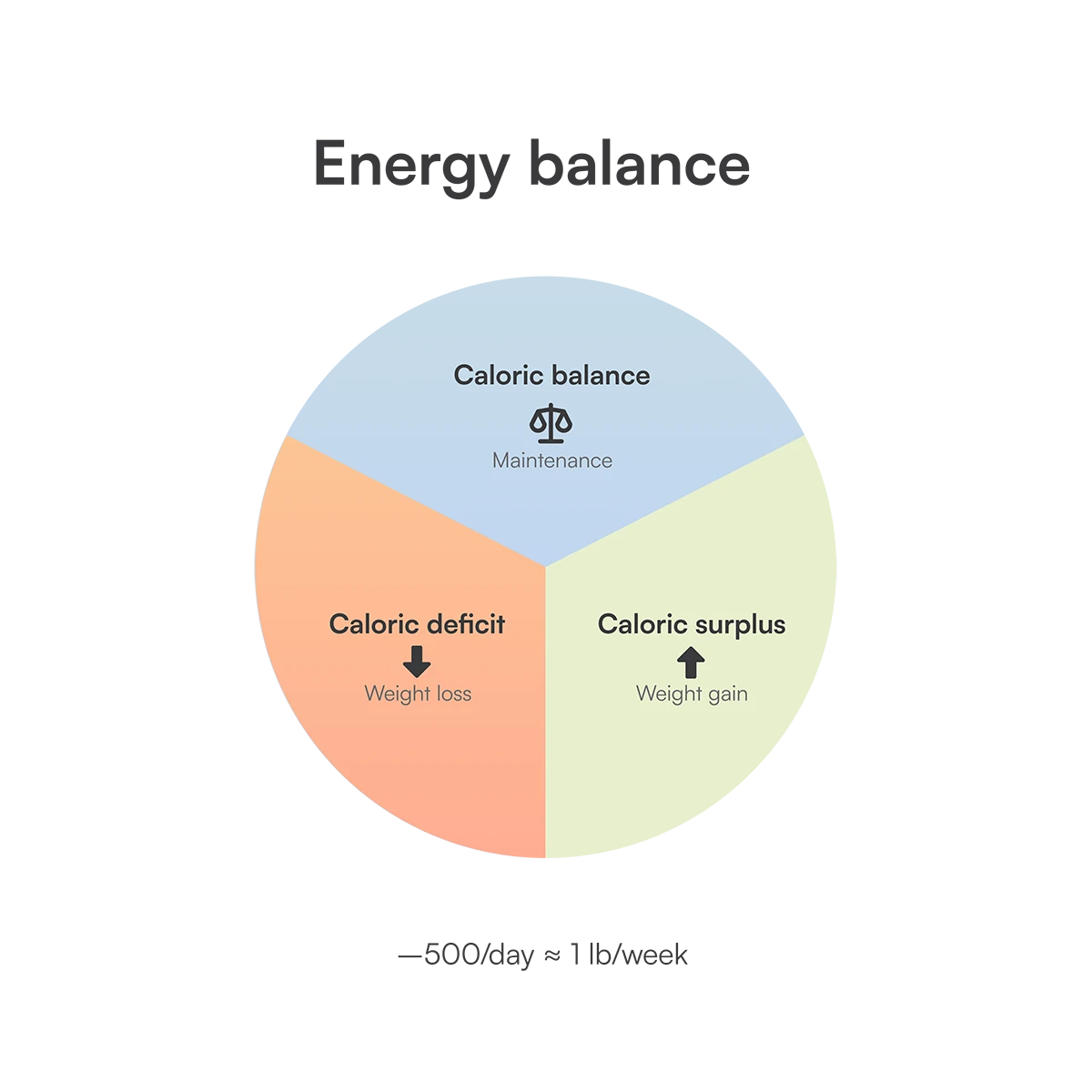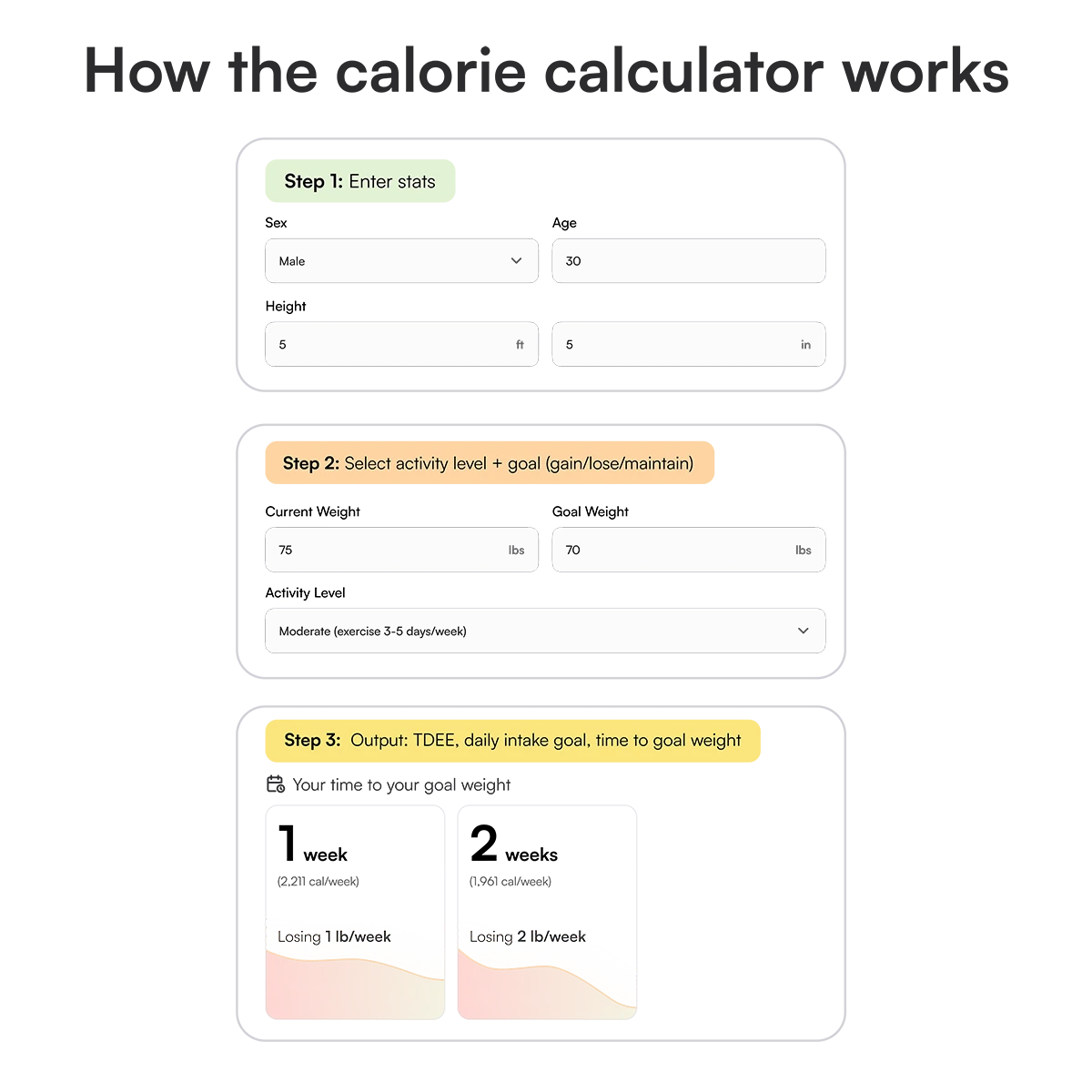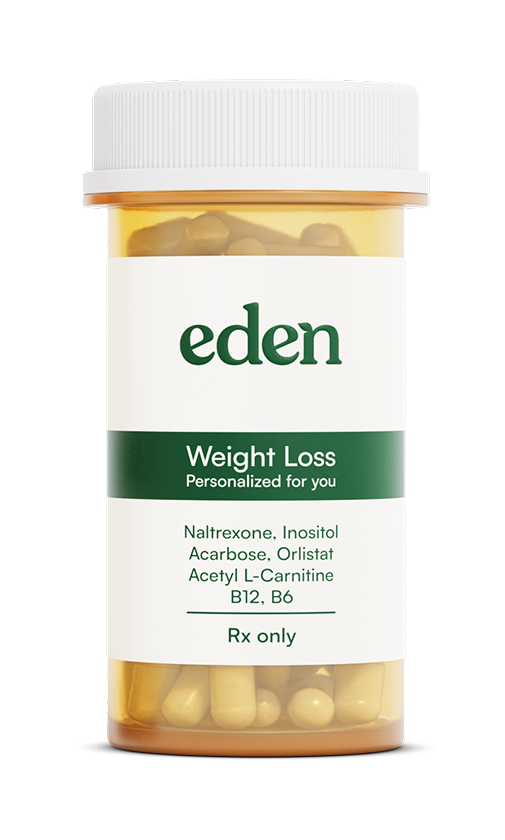Calorie Calculator: Achieve Your Weight Loss or Weight Gain Goals
Achieving your ideal weight—whether that means shedding excess pounds or gaining healthy mass—ultimately comes down to calories in vs. calories out. A calorie calculator is a tool that may help you plan your daily calorie intake to lose weight, gain weight, or maintain your current weight. By inputting your personal data (such as age, gender, height, weight, activity level, and goal weight) into the calculator, you can get guidance on how many calories you should consume each day to reach your target. This article will walk you through how the calorie calculator works, the understanding behind it, and tips for setting sustainable weight-loss or weight-gain goals. We'll also discuss sustainable rates of weight change, how to track your progress, and why a sustainable approach is essential for long-term success.
Please note that this calorie calculator is intended for informational and educational purposes only. The results are an estimate and are not intended to be a substitute for professional medical advice, diagnosis, or treatment.
Understanding Calories and Energy Balance
Calories are the units of energy we get from food and drink. Our bodies burn calories throughout the day through basic functions (breathing, circulating blood, cell production) and physical activities. The total number of calories you burn in a day is known as your Total Daily Energy Expenditure (TDEE) – essentially, this is your maintenance calorie level (the amount you need to eat to neither gain nor lose weight). TDEE includes your basal metabolic rate (BMR) – the calories your body burns at rest – plus all the calories you burn from daily activities and exercise. Everyone’s TDEE is different and may be influenced by factors like age, sex, body size, body composition, and activity level. A larger or more active person may burn more calories, while a smaller or sedentary person burns fewer.
Energy balance is the relationship between the calories you consume and the calories you burn:
- Caloric balance (maintenance): If you eat roughly the same number of calories as your TDEE, your weight will stay stable. For example, if your body uses ~2500 calories a day and you also consume ~2500 calories, you're in equilibrium.
- Caloric deficit (weight loss): If you consistently eat fewer calories than you burn, your body will tap into stored energy (body fat) to make up the difference, leading to weight loss. A deficit of about 3,500 calories is roughly equivalent to losing one pound of body fat. In practical terms, cutting ~500 calories per day below your maintenance needs (500 x 7 days = 3,500) may result in about 1 pound of weight loss per week, whereas a larger 1,000-calorie daily deficit may yield about 2 pounds per week. (We will discuss safe limits and recommendations in a moment.) Please note however, that these estimations may differ from individual to individual depending on other health considerations.
- Caloric surplus (weight gain): On the other hand, if you eat more calories than your body burns, the excess energy is stored – often as body fat or, with strength training, partly as muscle. About 3,500 extra calories beyond what you burn adds roughly one pound of weight. For example, eating ~500 calories above maintenance each day might cause about 1 pound of weight gain per week (500 x 7 = 3,500). A larger surplus would lead to faster weight gain, though not all of it will be lean muscle.

It’s important to note that these numbers (3,500 calories per pound) are estimates. Actual results vary from person to person due to differences in metabolism, hormone responses, and how the body adapts over time. Nonetheless, these figures provide a useful rule of thumb for planning a diet. Weight change isn't perfectly linear, because as you lose or gain weight, your metabolism can adjust (your TDEE changes). Still, the basic principle holds: to change your weight, you must change the balance between energy in and energy out.
How the Calorie Calculator Works
Our calorie calculator takes the guesswork out of this process by doing the math for you. It operates in a few steps:
- Estimating your maintenance calories (TDEE) – Based on the personal details you enter (age, sex, height, current weight) and your daily activity level, the calculator first computes your approximate TDEE. This is how many calories you burn per day and thus how many you’d need to eat to maintain your current weight. The calculator may use well-established formulas (like Mifflin-St Jeor or Harris-Benedict equations for BMR, multiplied by an activity factor) to get this estimate. If you happen to know your body fat percentage, entering it may improve the accuracy of the TDEE calculation, since muscle tissue burns more calories at rest than fat tissue. The activity level input is important – someone with a sedentary desk job will have a lower TDEE than someone who is on their feet all day or exercises intensely. By combining your BMR and activity level, the calculator determines roughly how many calories you need each day to keep your weight steady.
- Incorporating your goal – Next, you specify your goal weight and how quickly you want to reach it. Unlike a basic TDEE calculator, this calorie calculator is goal-oriented. You can indicate whether you aim to lose or gain weight, and choose a timeframe or a rate (for example, X pounds per week). For instance, you might input that you want to lose 20 pounds and plan to lose about 1 pound per week. The calculator will then determine how many weeks that would likely take (in this case, roughly 20 weeks) and what daily calorie intake is required to achieve that. If you specify a desired weekly weight change, the tool uses that to compute the total time to reach your goal weight. Conversely, if you input a target date or number of weeks, it can figure out the weekly weight loss/gain required. In either case, it will adjust the calorie recommendation accordingly.
- Calculating your daily calorie target – Using your TDEE as a starting point, the calculator subtracts calories to create a deficit (for weight loss) or adds calories for a surplus (for weight gain) that aligns with your goal pace. The result is a personalized daily calorie target to hit your goal weight in the intended timeframe. For example, suppose your maintenance need is 2,300 calories per day. If you want to lose ~1 pound per week, the calculator might advise around 1,800 calories per day (approximately a 500 calorie deficit). If you wanted to gain 1 pound per week, it might suggest around 2,800 calories per day (500 calorie surplus). The calculator essentially bridges the gap between where you are (current weight/TDEE) and where you want to be (goal weight) by prescribing a daily calorie budget tailored to your target rate of loss or gain.
- Outputting additional useful information – In addition to your daily calorie target, you’ll typically see an estimate of how long it will take to reach your goal (e.g. “approximately 5 months to reach 20 lbs weight loss at 1 lb/week”). The calculator may also display other helpful figures, such as:
- Your current maintenance calories: so you understand what your body needs now to stay at the same weight (from step 1).
- Your goal caloric intake: the number of calories to eat daily to hit your goal (from step 3).
- Your projected maintenance calories at goal weight: an estimate of how many calories you’d need to maintain your new weight once you get there. (As you lose weight, your maintenance needs drop a bit; as you gain, they rise. The tool can give you a sense of your future calorie needs at the goal weight.)
- Your current maintenance calories: so you understand what your body needs now to stay at the same weight (from step 1).

By laying out these numbers, the calorie calculator functions as a roadmap for your weight journey. It tells you what to aim for each day and what to expect long-term. Keep in mind that all calculations are estimates – real life progress can be faster or slower – but it’s a very useful starting point that you can adjust from as needed.
Setting Sustainable Weight Loss Goals
If your goal is to lose weight, it's crucial to set a plan that is both effective and healthy. You might be eager to see quick results, but overly aggressive calorie cuts can backfire. Health experts generally recommend a gradual, steady rate of weight loss rather than rapid drops. A typical safe rate is about 1 to 2 pounds per week (roughly 0.5 to 1 kg per week). This may not sound like a lot, but it’s actually a significant, sustainable pace. Losing just 5-10% of your body weight over a few months can yield major health benefits, such as improved blood pressure, cholesterol, and blood sugar levels. For example, if someone weighs 200 lbs, a 5% loss is 10 lbs – even this modest reduction can reduce risks of conditions like heart disease and type 2 diabetes.
To achieve a 1-2 lb/week loss, a general calorie deficit of about 500 to 1,000 calories per day from your maintenance level. This number may differ based on individual health conditions; please consult your provider for a deficit number for yourself. You can accomplish this through a combination of eating fewer calories and increasing physical activity. The calorie calculator will help by telling you how many calories to eat daily. For instance, if your maintenance (TDEE) is ~2500 calories:
- Aiming for ~2000 calories per day (a 500 cal deficit) could lead to ~1 lb/week loss.
- Aiming for ~1500 calories per day (1000 cal deficit) could lead to ~2 lbs/week loss.
⚠️ Don’t go too low: It might be tempting to cut even more calories to lose weight faster, but extremely low-calorie diets can be dangerous. Very low intake can deprive you of essential nutrients and slow down your metabolism. In fact, medical guidelines often advise that women should not eat below ~1,200 calories per day (and men not below ~1,500) except under doctor supervision. Severely restrictive diets can lead to fatigue, dizziness, gallstones, malnutrition, and other health issues. Always ensure your calorie target stays within a reasonable range to keep your body functioning well.

When you use the calorie calculator, choose a weekly weight loss goal that is realistic for you. If you have a lot of weight to lose, you might start at the higher end (2 lbs/week), whereas if you are closer to your goal or have underlying health issues, even 0.5–1 lb/week might be more appropriate. Remember that weight loss is not always perfectly steady – it's normal to have some weeks where the scale doesn't budge as expected. Overly aggressive goals (like trying to lose 5+ lbs per week) are usually not sustainable and can lead to burnout or injury. Slow and steady is the name of the game for long-term success.
What to Expect When Losing Weight
In the early weeks of a diet, you might see a sharper drop on the scale (especially if you reduce a lot of carbs or salt – your body sheds water weight initially). But fat loss happens gradually. Consistency is key: hitting your calorie target most days of the week will produce results over time. Here are a few points about the weight loss process, so you know what’s normal:
- Initial adjustments: When you first cut calories, you may feel a bit hungry or low-energy as your body adapts. Give yourself a couple of weeks to adjust to the new intake. Make sure the calories you do eat are rich in nutrients (lean proteins, veggies, fruits, whole grains, healthy fats) so you feel satisfied. High-fiber and high-protein foods are especially helpful for fullness. Drink plenty of water and spread your meals/snacks throughout the day to manage hunger.
- Plateaus: After losing a certain amount of weight, it's common to hit a weight-loss plateau where progress slows down or stalls. This happens because as you become lighter, your body burns fewer calories (your TDEE drops), and it may also adapt by becoming more efficient with energy. In other words, the calorie deficit that was once 500 calories may shrink as your metabolism changes. Hitting a plateau isn’t failure; it’s a signal that you might need to adjust. You can reassess your daily calorie needs at your new weight (try recalculating with the tool using your current weight) and perhaps increase activity or slightly decrease calories to kickstart progress again. Remember that mixing up your exercise routine or intensity can also help overcome a plateau by preventing your body from getting too accustomed to the same routine. Patience is crucial—“slow and steady” truly wins the race in weight loss.
- Energy and exercise: Incorporating exercise can allow you to eat a bit more while still losing weight, since exercise burns additional calories. The calculator's recommended calorie intake already assumes a certain activity level (which you selected). If you end up being more active than indicated, you may lose weight a little faster, or you could afford a few extra healthy snacks. Conversely, if you log fewer steps or workouts, weight loss might be slower. Aim for a balance – dietary changes and exercise together work best for improving body composition and health. Even brisk walking 30 minutes a day can significantly aid weight loss and help maintain muscle while you’re in a deficit.
- Sustainable changes: The best diet is one you can stick with. Make tweaks to your eating habits that you can imagine continuing long-term, not just a crash diet for a month. It's fine to enjoy occasional treats; just account for them in your weekly calorie budget. Many people find success using strategies like meal prepping, keeping a food diary or app, or practicing mindful eating to avoid overeating. Building these habits will make it easier to maintain your weight loss once you reach your goal.
Finally, celebrate non-scale victories too: maybe your clothes fit better, you have more energy, or your bloodwork at the doctor shows improvement. The scale is just one measure of progress.
Setting Realistic Weight Gain Goals
Weight gain can be just as challenging as weight loss, especially if you have a fast metabolism or a small appetite. Whether your goal is to reach a healthy BMI because you’re underweight, or to build muscle mass for athletic reasons, the calorie calculator can help map out a plan for gradual weight gain. Just like with weight loss, a slow and steady approach is ideal for weight gain. Packing on weight too quickly (by eating whatever you want in huge quantities) can lead to gains in unhealthy fat, not the lean muscle you might want, and could upset your digestion or energy levels. Instead, aim for a controlled calorie surplus and a reasonable weekly weight gain target.
Experts often recommend trying to gain about 0.5 to 1 pound per week as a healthy rate for most individuals. This typically means eating roughly 300–500 calories above your maintenance needs per day. At this pace, in a month you could be 2–4 pounds heavier. It might sound slow, but remember, you want quality weight (strong muscles, hydrated cells, robust bones), not just added body fat. If you are very underweight or in a hurry for a specific reason, you could aim for the higher end (around 1 pound/week or slightly more). A faster gain would require a larger surplus, perhaps 700–1000 extra calories per day above maintenance. However, be cautious – consistently eating, say, 1000+ calories beyond what you burn can cause excessive fat gain and digestive discomfort, and it's usually not sustainable long-term. Use the higher surplus approach only if needed, and ideally under guidance from a healthcare provider or nutritionist.
Illustration: Gaining weight healthfully involves gradually increasing calorie intake and building muscle mass, as depicted by the transition from an underweight figure to a healthier weight. When using the calorie calculator in weight gain mode, you'll input your goal weight and choose a weekly gain target. For example, if you currently weigh 130 lbs and want to be 150 lbs, a 20-pound gain:
- At ~1 lb/week, it would take about 20 weeks (5 months) and require roughly a 500 cal/day surplus.
- At ~0.5 lb/week, it would take 40 weeks (around 9 months) with a 250-300 cal/day surplus.
- The calculator will output an estimated daily calorie intake (e.g., "eat 2,700 calories per day") to reach 150 lbs in that timeframe. It will also project the number of weeks to reach the goal at that rate.
What to Focus on When Gaining Weight
Gaining weight isn’t an excuse to eat junk food without limit. Nutrition quality matters, perhaps even more so, because you need plenty of vitamins and minerals to support the growth of new tissues in your body.
Here are some key considerations for healthy weight gain:
- Balanced Macronutrients: Ensure you’re getting ample protein since it’s essential for building muscle and other lean tissues. The calorie calculator gives you a number for overall calories, but you should fill those calories with nutrient-dense foods. Lean meats, chicken, fish, eggs, dairy, legumes, nuts, and protein shakes are great protein sources. Protein is crucial for muscle repair and growth. Aim for a protein-rich food at each meal. Keep in mind protein is very filling, so while you need it, you may not want to overdo protein to the point it kills your appetite for other calories. Carbohydrates (whole grains, starchy veggies, fruits) and healthy fats (olive oil, avocado, nuts) are your friends – they pack more calories and help you maintain the energy needed for workouts. In fact, fat provides 9 calories per gram (more than double carbs or protein at 4 cal/g), making it an efficient way to add calories. Sprinkle extra olive oil on your veggies, add peanut butter to your oatmeal or smoothies, and don’t choose low-fat products unnecessarily.
- Frequent Meals and Calorie-Dense Foods: If you struggle with a small appetite, try eating smaller, more frequent meals rather than a few large ones. Have snacks handy (nuts, trail mix, yogurt, cheese, dried fruit) that are easy to eat and high in calories. Calorie-dense foods help you get more energy without feeling overly full – think nut butters, smoothies, milkshakes, avocado, granola, etc. For example, instead of just having a salad (which is healthy but low-calorie), add extra cheese, olive oil, seeds, or an extra slice of whole-grain bread with butter. The idea is to gradually sneak in calories wherever possible: an extra spoon of olive oil here, a handful of almonds there, maybe an evening snack before bed. Liquid calories can be useful too – drinking calories (like a protein shake or whole milk smoothie) might be easier than another plate of food if you’re already full.
- Strength Training: If your goal weight involves building muscle (and not just fat), resistance training is critical. Lifting weights or doing bodyweight exercises sends a signal to your body to convert those extra calories into muscle mass. Without exercise, most surplus calories (especially a large surplus) will end up as fat. The good news is that when you start strength training, beginners often experience quick gains in strength and some muscle size. Muscle tissue is denser and heavier than fat, so over time you might notice your weight going up and your physique improving. The calorie calculator will help ensure you have enough fuel to support these workouts and recovery. Always pair your exercise routine with adequate rest and recovery; muscle is built during rest when the body uses nutrients to repair the fibers you've exercised.
- Patience and monitoring: Just as with weight loss, weight gain should be tracked and adjusted. Try weighing yourself at least weekly, or even more frequently (under consistent conditions, like every morning after using the bathroom, before eating). This helps you see if you’re on pace. If weeks go by and you’re not gaining as expected, the calculator’s estimate might have been low – you may need to eat even more. It’s not uncommon to discover you need a slightly higher surplus, as individual metabolic rates vary. Conversely, if you gain weight too fast (more than ~1 lb/week) and especially if you notice a lot of fat gain around the midsection, you might dial back the calories a bit. The goal is a gradual, healthy increase, not a sudden bulk that could strain your system. And yes, gaining weight can come with its own discomforts – you might feel full more often or even a bit bloated as your body adapts to more food. Ramp up your intake slowly if needed.

Just like someone losing weight might hit plateaus, someone trying to gain might hit stretches where the scale refuses to budge upward. Don’t get discouraged – as long as you stay consistent with eating more, your weight will trend up. Sometimes your body might be using the extra energy to strengthen bones, improve organ function, or support other subtle changes before the scale moves. Keep at it, and consider increasing calories slightly or changing up your workout stimulus if progress stalls.
Tips for Success with Your Calorie Plan
Whether you're on a weight loss journey or aiming to gain weight, success comes from a mix of smart planning, consistency, and healthy habits. Here are some general tips to help you reach your goal and maintain the results:
- Set Realistic Goals and Milestones: Break your overall goal into smaller milestones. For instance, instead of focusing only on the final goal (“lose 50 lbs” or “gain 20 lbs”), set mini-goals like losing the first 5-10 lbs or gaining 5 lbs and celebrating that achievement. This makes a big goal less daunting. Also, understand that everyone’s body is different. Two people following the same calorie plan might lose or gain at different rates, and that’s okay. Avoid comparing yourself to others; use your own progress as the benchmark.
- Use the Calculator as a Guide: The calorie target you get from the calculator is an estimate based on population averages. It’s a fantastic starting point, but you may need to tweak it. Pay attention to your actual results. If you're consistently eating the suggested calories and after a few weeks you're not seeing the expected change, adjust slightly (e.g., eat a bit less if you’re not losing or a bit more if you’re not gaining). Listening to your body is important too – if you’re feeling excessively hungry or fatigued, that’s a sign your calorie deficit might be too large; if you’re feeling overly stuffed or sluggish, your surplus might be too high. The calculator gives you a number to aim for, but don’t ignore your own biofeedback.
- Prioritize Nutrient-Dense Foods: Make your calories count nutritionally. Whether cutting or adding calories, focus on whole foods that provide protein, fiber, healthy fats, vitamins, and minerals. These foods will help you feel satisfied and support your overall health. For weight loss, nutrient-dense foods allow you to eat a larger volume for fewer calories (think lots of vegetables, lean proteins, and high-fiber grains) which helps control hunger. For weight gain, nutrient-rich choices ensure that you’re building your body up with strong materials (for example, you need sufficient protein and calcium if you want to gain muscle and bone strength, not just fat). That said, for hard gainers, incorporating some calorie-dense treats is fine too (an extra slice of whole-grain toast with peanut butter, a glass of juice, etc.). Balance is key: even when losing weight, you can enjoy small treats; even when gaining, most of your foods should be nourishing.
- Stay Hydrated and Get Adequate Sleep: Drinking enough water is important for metabolism and can even help with weight loss (sometimes thirst is mistaken for hunger). For those gaining weight, don’t fill up on huge amounts of water right before meals, as it can reduce your appetite – instead, sip throughout the day. Sleep is a frequently overlooked factor; aim for 7-9 hours of quality sleep. Poor sleep can disrupt hunger hormones and recovery, undermining both weight loss and muscle gain efforts. Managing stress is also beneficial, as high stress can affect eating habits and where your body stores fat.
- Combine Diet with Exercise: The best outcomes typically come from pairing your nutrition plan with physical activity. For weight loss, exercise helps burn extra calories (so you have a bit more flexibility in your diet) and preserves muscle mass, which keeps your metabolism higher. Cardio exercises (like walking, jogging, cycling) are great for heart health and burning calories, while strength training (lifting weights, bodyweight exercises) is excellent for shaping your body and maintaining muscle while the fat comes off. For weight gain, as mentioned, strength training is almost a must if you want to ensure much of the weight you add is muscle, not just fat. Plus, regular exercise can actually increase your appetite by expending energy, which helps when you need to eat more. Exercise also has countless health benefits beyond weight—improved mood, better cardiovascular health, and more. Find activities you enjoy so that staying active becomes a fun routine rather than a chore.
- Monitor Progress and Be Flexible: Keep track of your weight regularly, but also use other measurements. If losing weight, you might track waist circumference or how your clothes fit. If gaining, you might track muscle measurements or progress in strength (like lifting heavier weights). Remember that scale weight can fluctuate daily due to water, glycogen (carb storage), and other factors. Look for trends over several weeks rather than obsessing about each day. If the trend is off from your plan, adjust your calorie intake by 100-200 calories up or down and see how that affects progress over the next couple of weeks. The ability to adjust is a strength, not a failure – it's part of the process.
- Stay Patient and Consistent: Perhaps the most important tip is to be patient with yourself. Weight changes, especially done the right way, take time. There will be good weeks and slower weeks. What matters is the overall trajectory. Consistency beats perfection – it’s better to follow your plan reasonably well most of the time than to be perfect for a short while and then give up. If you have a rough day or an off-track meal, don’t get discouraged; one day won’t ruin your progress. Get right back on track with your next meal. The accumulation of good choices over time is what leads to results.
Why a Sustainable Approach Matters
We've hinted at this throughout, but it's worth emphasizing: the best weight management plan is one that you can maintain for life. The calorie calculator is a tool to guide you, but it’s not a short-term hack – it’s helping you learn about your body’s needs. If you crash diet on an extremely low calorie intake, you might lose weight quickly, but you will likely feel miserable, and it's almost certain you'll regain the weight later (often with interest) when old habits resume. Similarly, if you try to force-feed yourself an extra 2000 calories a day to bulk up fast, you might gain weight quickly but end up gaining mostly fat or hurting your health and then have to diet all over again. It’s much better to aim for gradual, sustainable changes: the kind of eating and activity patterns you can envision sticking to most days, with a few indulgences or rest days in between.
A sustainable approach also means listening to your body's feedback. Use the calorie targets as educated guidelines, but pay attention to how you feel. Are you energetic, sleeping well, and generally feeling good? Those are signs your plan is working in a healthy way. If you’re constantly tired, obsessed with food, or experiencing physical issues (dizziness, extreme hunger or fullness, etc.), you may need to ease up. Your health is the top priority. The goal weight is pointless if the process of getting there makes you unwell.
Lastly, think about the long term: once you reach your goal weight, what next? The ideal outcome is that by following the calculator's guidance and integrating the tips above, you will have built habits that make maintaining your new weight second nature. The calculator even shows you an estimate of how many calories you'll need to eat to maintain your new weight. This gives you a preview of what your future diet should look like. In maintenance, you won’t have to be as strict as during the weight loss or gain phase, but you will still want to stick to the healthy habits learned (like watching portion sizes or eating frequent healthy meals). Remember, weight maintenance is just a continuation of the lifestyle changes you adopted – there’s no definitive end date where you abandon the plan. The good news is, if you do it right, you won't want to abandon it because you'll enjoy feeling healthier!
Conclusion: Take Charge of Your Goals
The calorie calculator provides a personalized strategy to reach your goal weight by demystifying how many calories you need each day. It translates the science of calories and metabolism into concrete daily numbers you can aim for. Whether you're trying to drop extra weight to improve your health or add pounds to feel stronger and more energized, knowing your daily calorie target is a critical first step. Armed with this knowledge, you can plan meals, adjust portion sizes, or tweak your exercise routine to create the calorie deficit or surplus you need.
Always remember that weight management is a journey, not a sprint. There will be ups and downs, but each day following your plan is a step toward a healthier you. Use the tool, apply the tips, and stay patient. And importantly, seek support when needed – friends or family who encourage your goals, fitness communities for motivation, or professional guidance from doctors and dietitians if you have unique needs or health concerns. Significant weight loss or gain should be done responsibly, so don’t hesitate to consult a healthcare provider, especially if you plan to go outside the typical recommendations (for instance, losing more than 2 lbs/week or if you have medical conditions). They can provide personalized advice and ensure you're doing it safely.
Empower yourself with knowledge and consistency. The calorie calculator is here to do the math, but you make the choices each day that add up to success. With a balanced diet, appropriate calorie intake, and a positive mindset, you can reach your goal weight and, most importantly, maintain it for the long haul. Here’s to your health and progress – one calorie, one meal, and one day at a time!
This calorie calculator is intended for informational and educational purposes only. The results are an estimate and are not intended to be a substitute for professional medical advice, diagnosis, or treatment. Eden does not provide medical advice. The information generated by this tool should not be used to make decisions about your health. Always seek the advice of your provider with any questions you may have regarding a medical condition or prior to starting any new regimens.























